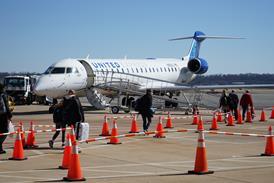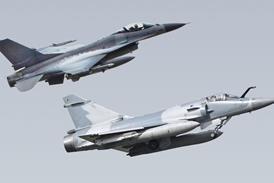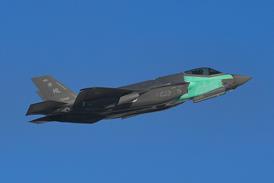Control of the multi-billion dollar maintenance budget for Boeing C-17s is the source for an increasingly public and bitter feud between the US Air Force and industry.
The USAF said in January it would take over management of the C-17 supply chain in fiscal year 2012, essentially firing Boeing from the job after a 12-year run. Responsibility for managing the F-22's supply chain also will be transferred from Lockheed Martin to the USAF.
The decisions mean hundreds of millions of dollars in programme integration costs will shift from industry balance sheets to government accounts.
|
|---|
But the largely internal argument has now spilled over into the public arena, with one high-ranking industry executive publicly criticising the USAF's reasoning for the decision.
William Begert is the vice-president for military international programmes and business development with Pratt & Whitney Military Engines, which makes the C-17's PW2000-derived F117 engine. But Begert is well-known among senior USAF staff after retiring in 2005 as a four-star general in command of all air force units in the Pacific region.
Begert aired his concerns about the performance-based logistics (PBL) decision on 22 April at the MRO Americas convention, where he spoke on a panel.
In a meeting two weeks before, a senior USAF official told him that the air force did not trust the official database used to calculate the cost of maintaining aircraft, Begert says. The database - called Air Force Total Ownership Cost (AFTOC) - shows the C-17 has the second lowest cost per flight hour of any air force aircraft and has been declining steadily for several years, Begert says.
According to Begert, the USAF official said the database is unreliable for calculating actual maintenance costs. The official added that the business case analysis shows the C-17 is more expensive to maintain under Boeing's PBL contract than the older Lockheed C-5 fleet, which is maintained under the air force's control at the Warner Robins Air Logistics Center in Georgia.
The official's statements about the C-17 cost stunned Begert, who previously commanded a C-5 wing. If true, the air force's statements would certainly appear provocative. The C-17 was designed two decades after the C-5. Moreover, the C-5 faces severe maintenance challenges. The air force is investing $11 billion to improve the reliability and re-engine half of the C-5 fleet, which is partly intended to reduce the cost per flight to operate the aircraft.
The USAF says it could not verify statements between Begert and a specific air force official. Leaders and industry meet regularly to have "open and frank discussions", but the conversations are not recorded, it says.
However, the air force's official position on maintenance costs for C-17s relative to the C-5 is not quite as Begert says he was told.
Rather than assert that a C-5 specifically costs less to maintain than a C-17, the business case analysis performed last year showed aircraft managed by the air force's "organic" depot system is cheaper, in general, than programmes managed by contractors, the USAF says.
The business case analysis "showed it is cheaper to sustain organic legacy systems such as C-5 because it is organic and we pay no pass-through costs," the USAF says, adding: "Thus why we are moving to government product support integrator."
Pass-through cost is one of the key issues in the dispute between the air force and industry. It is the mark-up price a contractor with an integrator role charges for ordering parts or services from another supplier.
The air force argues that the same order placed by one of three major depots - which the USAF calls air logistics centres - is cheaper because the depot does not charge a pass-through fee. As government-owned organisations, the depots also are not obliged to make a profit, but only to recoup the cost of labour, materials and overhead.
By assuming control of the C-17 supply chain, the air force reasons that it saves money by eliminating the contractor standing in the middle of a quite straightforward transaction.
The industry, of course, views the value of their role in the public partnership formed to sustain the C-17 fleet differently.
Rather than simply being a redundant fee on top of an already placed order, companies such as Boeing believe that in exchange for the so-called "pass-through" cost, the government receives a benefit worth paying for.
"I don't like the word 'pass-through' because it sounds like there is no value added," says Gus Urzua, Boeing vice-president and programme manager of the C-17 Globemaster Sustainment Partnership, the name of the PBL deal since 2004.
"We integrate, orchestrate. We make sure we don't sub-optimise the weapon system by being the integrator," he says. "That is a value-added proposition."
The value is created because of a unique feature of PBL deals. Boeing guarantees aircraft availability at a fixed cost. For the C-17 programme, Boeing must ensure the fleet averages 90% availability at all times, or is penalised.
As a result, Boeing has a different set of incentives than depots, which traditionally do not provide such guarantees of fleet availability at fixed rates.
Urzua cited a comment he heard from a manager at one of his suppliers: "The manager said, 'before PBLs, every component that came in I saw as revenue. In a PBL environment every repair I see is a cost. As a result, you don't see those repairs coming in as often'."
In one specific case, Urzua says Boeing was not pleased with the performance of a supplier maintaining the auxiliary power unit. So Boeing recompeted the job, awarding the work to Triumph, which improved availability and lowered the cost of auxiliary power units. In Urzua's opinion, that is the value the air force receives for the pass-through fee.
Boeing, however, confronts greater forces than the air force's opposition to the pass-through fees in PBL contracts. The air force's recent decisions on such deals have been guided by a series of policy changes.
Last year, the Obama administration rolled out a plan to bring mostly white collar jobs held by contractors in-house, arguing that government employees could do the same work cheaper.
Also last year, Congress passed the Weapon System Acquisition Reform Act, which took particular aim at prime contractors functioning as integrators. The new law created a new role in every programme office called product support manager, ensuring the government retains the ability to integrate its own supply chains.
However, the new law was expected to apply to the development and production phases of the acquisition process, and the air force surprised industry by extending the policy to the sustainment phase.
So far, the air force is alone among the services in its efforts to bring maintenance programmes covered by PBLs in-house. The Office of the Secretary Defense continues to advocate them as the preferred approach for maintaining weapon systems. Meanwhile, the navy and army plan to increase the use of performance-based contracts to maintain weapon systems.
Since the concept was introduced in the late 1990s, PBL deals have redefined the relationship between contractors and the government. The contractor guarantees aircraft availability at a fixed rate.
The air force, however, is not persuaded that the cost of those guarantees makes the deal worth it, given the service already operates a large depot infrastructure.
Under a well-structured five-year agreement, the contractor makes a small profit or loses money in the first two years. The supply chain is still not mature and investments must be made. The payoff for the contractor occurs in the last two years, when profit can exceed 20% even as the overall cost per flight hour to sustain the aircraft declines. Such profit margins for government work can appear excessive.
Dan Goure, vice-president at the Lexington Institute, opposes the air force's decision on C-17 PBL. If the air force had qualms about Boeing's profit margin, the service should negotiate a better deal.
"So go negotiate a change," Goure says. "That's not written in stone. Are you blaming Boeing because you write stupid contracts?"
For its part, industry is rallying to address the risk that the government will move to eliminate more PBL arrangements, removing a key source for projected profit growth over the next decade.
Industry officials want to develop standard cost metrics to make accurate comparisons between the cost of maintenance between the private sector and government depots.
"We need to find some common set of ground rules and processes to be used in the business case analyses," Urzua says. "If nobody believes the cost, nobody believes the AFTOC database, how are we making cost and affordabilty decisions from those."
Source: Flight International
























